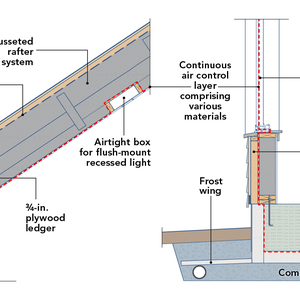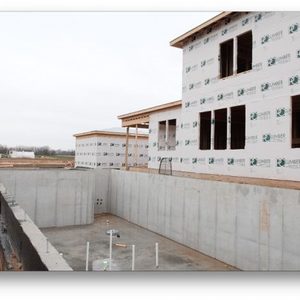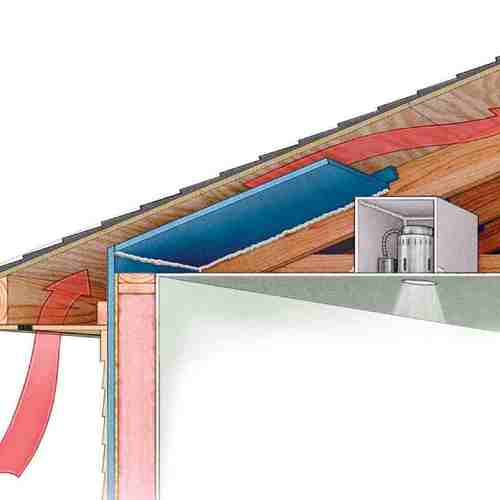
Tyler Keniston is pondering design details for an energy efficient home in Climate Zone 6A. He’s thinking of a Pretty Good House—a home that’s energy efficient but not overly fussy—and he’s has run into a design conundrum.
Based on what he’s read at GBA, the ideal design seems to be a house without a full basement and with an unconditioned attic, Keniston writes in this Q&A post. So where does your extra junk go?
“Basements are traditional but arguably not the most cost-effective solution to build a PGH,” he says. “They are a hole in the ground with the requisite water issues, use a lot of concrete, and cost a lot.” A traditional cold attic, insulated at the ceiling plane, is more cost-effective and probably a more robust design than insulating at the roofline.
“All well and good,” Keniston says. “But when it comes time to talk someone into adopting both of these approaches, they might wonder where they are going to put all their ‘extra stuff.’ ”
One approach is to build a bigger house, but in doing so the benefits of using the bonus space inherent with basements and attics are unrealized.
“To be more specific,” he adds, “if the primary goal is to forgo a basement for the aforementioned reasons, might it be sensible to consider insulating the roofline to gain the bonus 1/2 story under the roof? Consider that the structure is wide enough (28 feet by 32 feet) and the roof pitch steep enough (10:12) that the ‘bonus’ attic space would be quite large and livable.”
And that’s the theme for this Q&A Spotlight: attic, basement, or something else?
Build a storeroom on the main floor
Jonathan Blaney notes that in addition to problems associated with moisture and either…
Weekly Newsletter
Get building science and energy efficiency advice, plus special offers, in your inbox.

This article is only available to GBA Prime Members
Sign up for a free trial and get instant access to this article as well as GBA’s complete library of premium articles and construction details.
Start Free TrialAlready a member? Log in















13 Comments
This has been a major issue for the house we are building, as it has needed to be a handicapped accessible home. It's a 1,300 sq ft single story ranch, with a conditioned crawl space and ventilated truss attic. But the required wider hallway, doorways, bathrooms, etc has also cut down on potential storage areas.
We've added some storage space by creating a window seat on one wall, which is surrounded on both sides and underneath with storage cabinets. Each bedroom has a 7 foot wide closet. There is a 3 foot wide closet off the hallway and a 5 foot wide closet in the entry foyer. We have a breakfast nook with a booth (with wheel chair access at the end of the table), with seasonal storage under the booth seats. And a 2 foot square by 6 foot high pantry. We're creating some narrow storage shelving inside an interior 6" thick bathroom wall, and a couple storage shelves above our electric water heater in our utility room. We also have a 12' x 16' shed.
But most importantly (not mentioned at all in this article), is that we have drastically purged our belongings. Most people simply own far too much stuff.
Forgive me for bristling, but "most people have too much stuff" is a judgmental statement and not the question at hand, which is, "What is the best place to add storage". Like it or not, people want storage for various morally defensible reasons.
Just remember what George Carlin said:
"My shit is stuff. Your stuff is shit."
+1 for "most people have too much stuff."
Nothing makes you examine the things you own like packing them up to move. If you feel you need everything you have after that, then you have been much more disciplined in your acquisitions than me.
My Aunt told me that after her house burned down, she felt liberated from the burden of all her stuff. She had raised 9-kids and a half dozen foster kids in that home and it was packed so much that some rooms were unusable. Personally, I found that moving to a 1-bed apartment while I built a new home had a similar effect. Now, that I have moved to that much smaller home, I find that I just keep letting go of my stuff. My attic is empty, my basement is empty. Now, I am ready to downsize even further.
My solution: if you have the space for it, build a separate storage shed. It's much cheaper than adding space to the house, there are no compromises on performance of the envelope or space for stairs of the main house, and it's probably easier to access than an attic.
In my region, a bonus is that mice will find their way in and eat anything moderately edible, nest in anything soft, and poop on everything. Then, if you find time to sort though the aftermath, you have a great excuse to get rid of the extra stuff that you probably didn't need anyway. I'm still working on that last step.
Charlie,
That's what I did too. First an unconditioned one for my tools, then a second conditioned she-shed for my wife's stuff. I was surprised at how much they ended up costing. I guess I shouldn't have been as they include an awful lot of the same things that make house so expensive.
Dry, secure, rodent-proof storage.
It's ugly, and takes up space, luckily we have room so we don't see it from the house.
Having space on the property was key while building the house and pole barn.
Insulation and lights made it more useful, and comfortable to be in. We'll continue to use it for gear storage after the house is done. (climbing, camping, bike, water stuff in the summer; and ski, snowshoe, mountaineering in the winter.) Our neighbor did offer to buy it, I'm sure it has as much or more value now (insulation and lights added by us) than when we bought it.
We put dry, unconditioned storage in the garage attic. It's a place for seasonal stuff like window screens and holiday decorations, as well as for items that don't get used too often, like our giant lobster pot.
Inside our Pretty Good House, I built in a lot of storage. Window seat in the bedroom has big drawers underneath for blankets, linens, etc. On each side are bookshelves.
The bed isn't against a wall, but sort of in the middle of the room. The headboard is a drawer unit 5 feet tall, with drawers on the side away from the bed. The photo shows the back of the headboard.
In the bedroom, I managed to fit 46 drawers, around 10 linear feet of hanging closet space and about 80 linear feet of shelves. I think built-ins are a very effective use of space, as opposed to free standing furniture.
A vote for basements.
I know they are imperfect, especially considering the embodied energy and carbon in concrete, but I'm a fan of basements.
They don't have to be damp or problematic. In our PGH in TN we built a walk out basement following the guidance in the Oak Ridge foundations handbook: https://foundationhandbook.ornl.gov/handbook/chapter2.shtml
We also fully excavated under the adjacent covered porch, which allowed us to have another full frame wall for the basement, separating the basement from the storage area under the porch. That way our basement has two frame walls and two block walls, insulated on the exterior. We took extra steps in detailing for water sealing and drainage.
Disadvantages are the additional costs and aforementioned energy/carbon footprint. Advantages are a lot of great storage and additional square footage within the same "umbrella" of the house. It's also an easy way to build in a storm shelter, which we did. I really like having all of that space for our mechanicals. Heat pump, ERV, water heater, well water filtration, wood stove for emergency heat, and breaker box are all in my basement away from the main living space. That frees up quite a bit of square footage in the main areas. In fact, without a basement, I would have built a larger home to accommodate all of that.
I suppose either way, if you can take advantage of space above or below your home, it can allow you to build smaller.
Cory
I used a simple modified scissor truss through the whole house, leaving some areas vaulted for extra drama, and putting drop ceilings over bathrooms, closets, etc. creating space within the conditioned building envelope for both storage and HVAC.
Paul Eldrenkamp talks about a deep-attic retrofit, where you shred the contents of your attic to make insulation. An excellent strategy!
Storage is definitely a big issue. We try to move as much of it as we can out of the conditioned space - above the garage if there is one, often. But I often describe my job as "Stuff wrangler" and finding the sf for enough is tricky. I do think most people have too much stuff and that it is not healthy, psychologically or environmentally. So I really liked Annette's thoughts on careful use of space for storage. I also think our "stuff" needs are pretty elastic and will expand or contract depending on available room.
I once saw photos of a house where the entire wall on both sides of the main-floor hallway are floor to ceiling veneered plywood doors that make the walls look like simple paneling. The house was designed so that the walls were thick enough to have essentially a shallow closet running the full length of the hall on both sides. This not only puts all the stuff that you hate dragging in and out of your basement or attic conveniently hidden close to where you might use it, but it also provides a sound buffer between the bedrooms and the public spaces in the house. If I ever build a new house, this is definitely going to be a must-have feature.
Log in or become a member to post a comment.
Sign up Log in